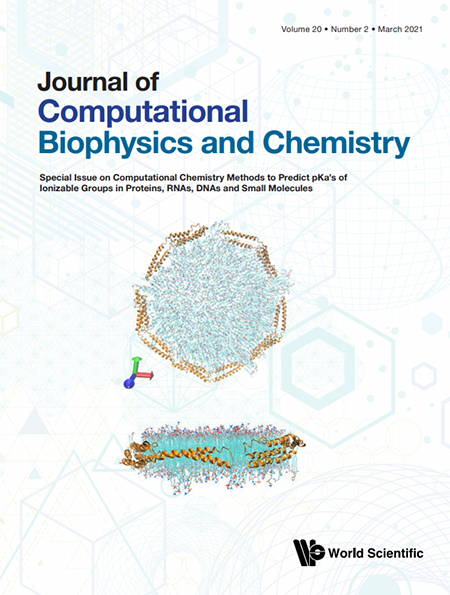System Upgrade on Tue, May 28th, 2024 at 2am (EDT)
Existing users will be able to log into the site and access content. However, E-commerce and registration of new users may not be available for up to 12 hours.For online purchase, please visit us again. Contact us at customercare@wspc.com for any enquiries.
Volume 20, Issue 02 (March 2021)
Special Issue: Computational Chemistry Methods to Predict pKa’s of Ionizable Groups in Proteins, RNAs, DNAs and Small Molecules
No Access
Editorial: Special Issue on Computational Chemistry Methods to Predict pKa’s of Ionizable Groups in Proteins, RNAs, DNAs and Small Molecules
- Pages:109–110
No Access
Characterizing the Water Wire in the Gramicidin Channel Found by Monte Carlo Sampling Using Continuum Electrostatics and in Molecular Dynamics Trajectories with Conventional or Polarizable Force Fields
- Yingying Zhang,
- Kamran Haider,
- Divya Kaur,
- Van A. Ngo,
- Xiuhong Cai,
- Junjun Mao,
- Umesh Khaniya,
- Xuyu Zhu,
- Sergei Noskov,
- Themis Lazaridis, and
- M. R. Gunner
- Pages:111–130
https://doi.org/10.1142/S2737416520420016

- •Water is the primary cellular solvent, yet is challenging to simulate computationally. Here we simulate water molecules in the Gramicidin A channel comparing Monte Carlo (MC) sampling with a continuum electrostatics and Molecular Dynamics (MD) calculations with the non-polarizable CHARMM36 and polarizable Drude force fields.
- •These give different water properties, with classical MD yielding well oriented water wires, while the Drude or continuum electrostatics force fields lead to more disordered water molecules, often changing orientation in the middle of the channel.
No Access
Quantum-Chemical ab initio Study of Side Chain pKa of Linear and Cyclic Lysine Dipeptides
- Pages:131–139
https://doi.org/10.1142/S2737416520420028

- •Cyclic dipeptides have attracted a great deal of attention due to their superior biological properties.
- •In this study, DFT and thermodynamic cycle were used to calculate the pKa value of the lysine side chain in linear and cyclic dipeptides.
- •Our results show that the acidity of cyclic lysine dipeptides is less than linear ones.
No Access
Expansion and Additional Validation of PKA17: A Fast Real-Time and Web-Based pKa Predictor
- Pages:141–152
https://doi.org/10.1142/S273741652042003X

- •We have developed PKA17, a coarse grain predictor of pKa values of protein residues.
- •The performance of PKA17 has been compared with that of PROPKA, DelPhiPKa, and H++, it has been shown to be fast, accurate, and robust.
- •PKA17 can be run by using a website interface at http://kaminski.wpi.edu/PKA17/pka_calc.html.
Open Access
pH-Dependent Interactions of Apolipophorin-III with a Lipid Disk
- Yunhui Peng,
- Rudolfs Kelle,
- Chandler Little,
- Ekaterina Michonova,
- Kostantin G. Kornev, and
- Emil Alexov
- Pages:153–164
https://doi.org/10.1142/S2737416520420041

- •The binding of Apolipophorin to a lipid disk involves large conformational change which is pH-dependent.
- •Thus, pH is an important regulator of Apolipophorin association with lipids and plays an important role in insect immune reaction.
No Access
Titration of Adenine in a GA Mismatch with Grand Canonical Simulations
- Zhe Huai and
- Zhaoxi Sun
- Pages:165–173
https://doi.org/10.1142/S2737416520420053

- •The high pKa shift in the unconventional GA mismatch in a 35-nucleotide single-stranded RNA hairpin is calculated with grand canonical simulations.
- •The single-configuration-based pKa prediction method named DelPhiPKa cannot reproduce the significant pKa shift.
- •Our constant pH simulations with two system setups consistently provide predictions in agreement with the experimental reference.
Open Access
Computing Protein pKas Using the TABI Poisson–Boltzmann Solver
- Pages:175–187
https://doi.org/10.1142/S2737416520420065

- •To compute protein pKas, a continuum dielectric Poisson-Boltzmann model defined on a molecular domain and a solvent domain is used for computing the related electrostatic free energies (top left).
- •The PB model in its boundary integral form is accurately solved on the triangulated molecular surface (e.g. BPTI) accelerated by a fast Treecode algorithm (top right).
- •The method obtains the intrinsic pKa and then computes the protonation probability for a given pH including site-site interactions by going through an energy driven titrating procedure. Comparison with experimental results are provided (bottom left and right).
No Access
The Design of Temperature and pH-Responsive Drug Delivery System Based on Cellulose and Aminated Cellulose by Computational and Experimental Methods
- Pages:189–200
https://doi.org/10.1142/S2737416520420077

- 1.Computational analyses of cellulose and aminated cellulose as drug carriers
- 2.Analyzing dynamics simulations in different protonation and temperature states
- 3.Experimental in vitro release of loaded drug in cellulose and aminated cellulose
No Access
The Electrostatic Features of Dengue Virus Capsid Assembly
- Pages:201–207
https://doi.org/10.1142/S2737416520420089

Understanding the fundamental mechanisms of dengue virus is highly demanded to develop treatments for dengue virus caused diseases. Here we present a computational work which focused on the stability of dengue viral capsid. This work found that the E proteins of dengue virus can survive in a wide range of pH, which can explain why the dengue virus is so widely distributed in the world and spreads fast.

